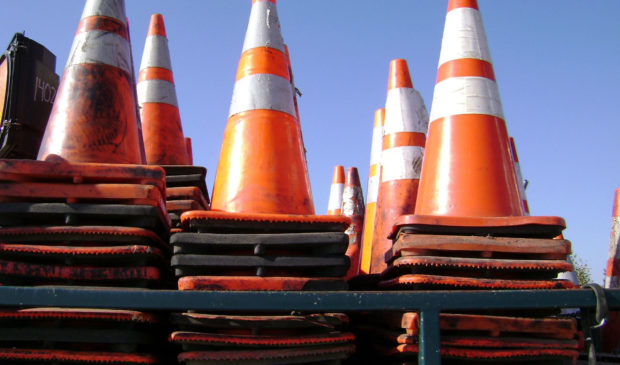Chamber says land reform is top transportation priority
Wednesday, September 21, 2016 by
Caleb Pritchard The Austin Chamber of Commerce has a new primary pill in its prescription for treating the city’s notorious traffic congestion, but it’s one that’s been known to cause many a case of political hives: density.
The group will unveil that recommendation along with several others that make up the meat of its 2016 Mobility Report at an event on Wednesday featuring Mayor Steve Adler.
“I don’t think it’s any secret that, fundamentally, our transportation problems can be traced directly to our development patterns, which by and large are characterized by sprawl,” Andy Cantú, the chamber’s director of regional mobility, told the Austin Monitor in an exclusive interview last week. Cantú edited the 46-page, heavily annotated report, which identifies Austin’s land use as “The original sin.”
“Increases in sprawl are associated with a number of negative outcomes and are proven to increase mobility problems,” it reads. “Public transit is less accessible and commuters are forced to spend more of their income on transportation. For disadvantaged communities in particular, overreliance on single-occupancy vehicles limits physical as well as economic mobility.”
The chamber last published a mobility report in 2013. The latest version’s foreword notes that since then, City Council converted to geographic representation, voters overwhelmingly rejected a $1 billion roads and light rail referendum, and Uber and Lyft left town following a disastrous electoral defeat of their own.
“There are also some positive developments,” the introduction claims. Among them, the gelling of plans to rebuild Interstate 35 and the redirection of state monies into highway projects.
The report goes on to outline the chamber’s new roadmap for tackling the mobility issues that plague the region. In June, in a poll conducted on behalf of the Monitor, 51 percent of respondents identified transportation as the paramount problem facing Austin.
The three “broad strategies” the new report addresses are land-use reform, alternatives to single-occupant vehicles and transportation demand management, a technical catch-all that includes telecommuting, flex scheduling and managed toll lanes.
While the 2013 report included those three strategies, its top priority was the embrace of the Capital Area Metropolitan Planning Organization’s long-range plan, then known as CAMPO 2035. That document identified $28.4 billion of mostly road projects, totaling nearly 2,000 miles of new lanes across six counties.
Cantú told the Monitor that the older report took an all-of-the-above approach.
“And when you do take an all-of-the-above approach, unless you articulate what some of the alternatives might be, it’s very easy to sort of settle into the status quo, which in Austin means more highways and building more free capacity and focusing exclusively on that,” said Cantú.
He explained that while preparing the new report, his team started with a broad look but filed it down to find the mechanisms and strategies that provide “the greatest bang for our buck in terms of promoting greater mobility in the region.”
That interest in return on investment opens the chamber up to critics who drubbed the 2014 light rail proposal as a suboptimal choice of projects. Its huge price tag and relatively low ridership projections – due in part to a route that bypassed some of the city’s densest neighborhoods – could have drastically cut into the Capital Metropolitan Transportation Agency’s operating budget, which could in turn have hurt the agency’s bus service, those critics argued.
“I don’t think I would characterize the 2014 bond proposal as a bad plan or a bad investment,” Cantú said in the chamber’s defense. “It might not have been the perfect plan. And I think a lot of people and groups in Austin are looking for perfection, and perfection is the enemy of good enough.”
In the meantime, Austin is considering a new transportation bond proposal, the $720 million package championed by the mayor.
Both land-use reform and mode-shifting have been addressed in some form by boosters of that plan, which Adler debuted at a chamber luncheon in May. The chamber subsequently endorsed it and dispatched representatives to speak on its behalf this summer as City Council considered placing it on the November ballot.
The bond’s key feature – $485 million for projects along a handful of the city’s major corridors – has been sold as a means of easing affordability concerns by driving density in areas outside of single-family neighborhoods. And several of the corridor improvement plans, which identify the specific projects to be funded, include a smorgasbord of bike, transit and sidewalk spending.
That plan, and its emphasis on density, has drawn an unwelcome reception from the powerful Austin Neighborhoods Council. Last week, the ANC set a deadline for Council to address the group’s concerns with the proposal or risk losing the group’s support for it.
Cantú said that any concern that the chamber wants to see high-rise condos replace single-family neighborhoods is sourced from a “false dichotomy.”
“We’re not saying that we need to make the entire region as dense as downtown,” he said. “But there needs to be a broader range of options for living and working that today don’t exist in Austin or only exist in really limited quantities.”
The Austin Monitor’s work is made possible by donations from the community. Though our reporting covers donors from time to time, we are careful to keep business and editorial efforts separate while maintaining transparency. A complete list of donors is available here, and our code of ethics is explained here.
You're a community leader
And we’re honored you look to us for serious, in-depth news. You know a strong community needs local and dedicated watchdog reporting. We’re here for you and that won’t change. Now will you take the powerful next step and support our nonprofit news organization?











